
The Solar-Terrestrial Centre of Excellence (STCE) is a collaborative network of the Belgian Institute for Space Aeronomy, the Royal Observatory of Belgium and the Royal Meteorological Institute of Belgium.
 |
Published by the STCE - this issue : 28 Nov 2014. The Solar-Terrestrial Centre of Excellence (STCE) is a collaborative network of the Belgian Institute for Space Aeronomy, the Royal Observatory of Belgium and the Royal Meteorological Institute of Belgium. |
| Archive of the newsletters | Subscribe to this newsletter by mail |
With only one more month to go in 2014, huge NOAA 2192 is very probably going to be *the* sunspot group of the year. After its impressive performance just a few weeks ago (see http://stce.be/news/280/welcome.html), observers and forecasters were counting down to its re-appearance at the solar east limb. NOAA 2192 obliged by starting its encore performance on 12 November, getting itself a new name: NOAA 2209. Unfortunately, as is sometimes the case with sequels of blockbusters, this group did not live up to the expectations.
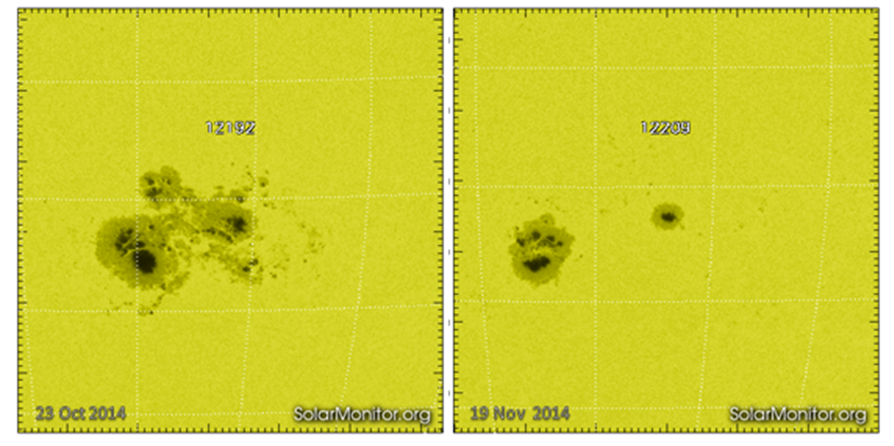

To begin with, NOAA 2209's outlook was much less spectacular. Its sunspot area was hardly one third of that of its illustrious predecessor (see graph above, and Note 1). Basically, only the leading and trailing portion were remaining, with hardly any sunspots in between. The group had grown in length, but significantly lost in sunspot area. The difference can also be seen in the pencil drawing underneath made by Jef De Wit from the Belgian Solar Section (http://www.vvs.be/werkgroepen/werkgroep-zon).
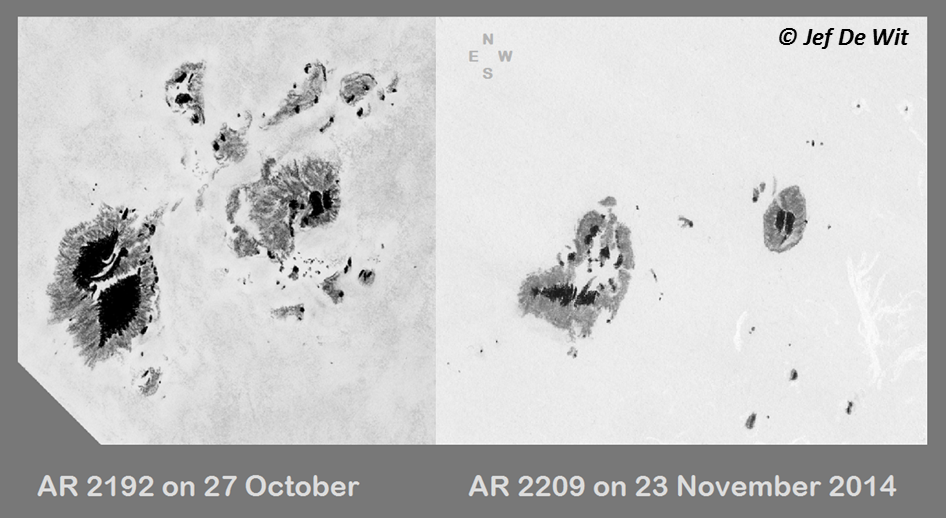
The trailing portion was the largest spot of the group, and many observers mentioned it looked like a bear claw. "Papa Bear" was still visible to the naked eye (using eclipse glasses). Quite a few attendees of last week's ESWW11 (http://stce.be/newsletter/pdf/2014/STCEnews20141120.pdf) took the opportunity to observe the group up close and personal.
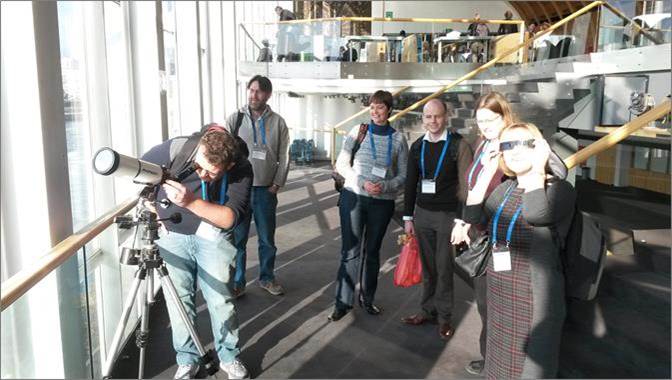
The bear claw was magnetically still complex, with a persistent delta spot. Unfortunately, except for a brief hiccup on 15-16 November when it produced 3 M-class flares, nothing spectacular happened. Compared to NOAA 2192, NOAA 2209 produced only half of the number of C flares, a fraction of the number of strong flares, and no X-class flares - as can be seen from graph underneath.
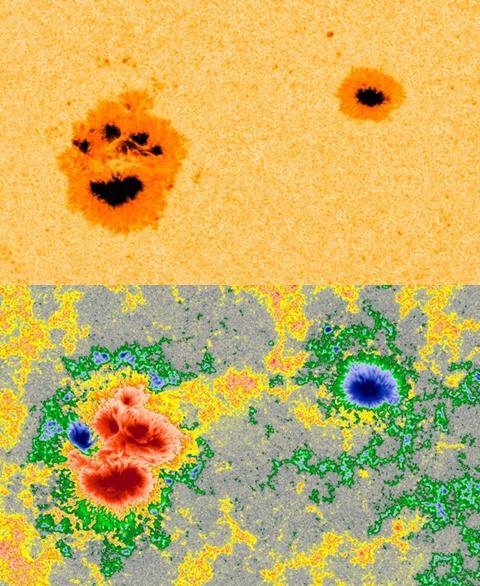
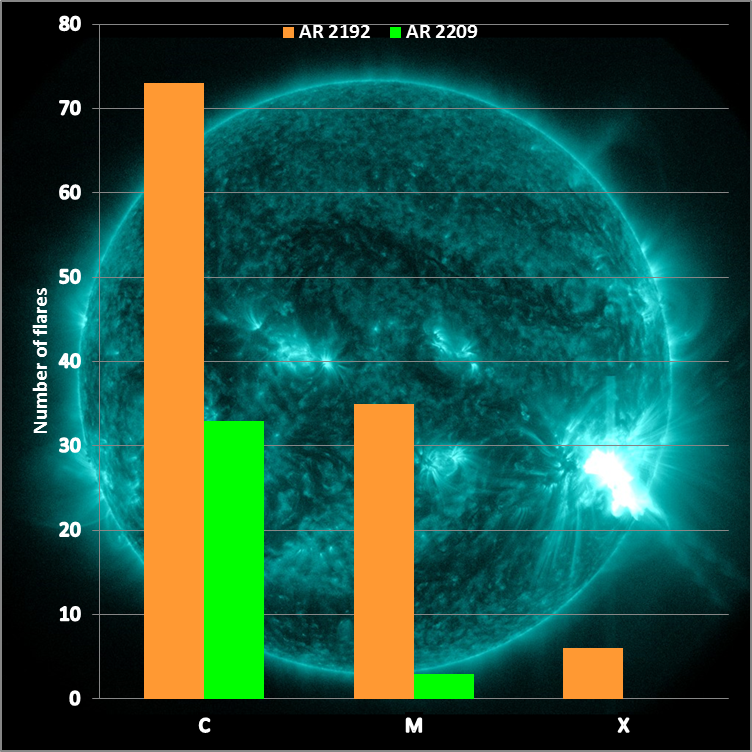
It would be no surprise if NOAA 2192/2209 would survive another farside transit. However, expectations are that by then it will be even smaller and less active. Nonetheless, it may still be worthwhile to get yourself a front-row seat-ticket for another sequel of this smash hit.
Note 1 - MH: Millionths of a solar hemisphere, with 1 MH corresponding to about 3 million km2. The total area of the Earth corresponds to about 167 MH, which is a good reference when comparing big sunspot groups.
Credits - Data and imagery were taken from SDO (http://sdo.gsfc.nasa.gov/data/aiahmi/), NOAA/SWPC (http://www.swpc.noaa.gov/today.html), NASA/MSFC (http://solarscience.msfc.nasa.gov/greenwch.shtml), and SolarMonitor (http://www.solarmonitor.org/index.php).
Solar flare activity remained low during the week.
In order to view the activity of this week in more detail, we suggest to go to the following website from which all the daily (normal and difference) movies can be accessed: http://proba2.oma.be/ssa
This page also lists the recorded flaring events.
A weekly overview movie can be found here (SWAP week 243).
http://proba2.oma.be/swap/data/mpg/movies/WeeklyReportMovies/WR197_Dec30_Jan5/weekly_movie_2013_12_30.mp4
Details about some of this week's events, can be found further below.
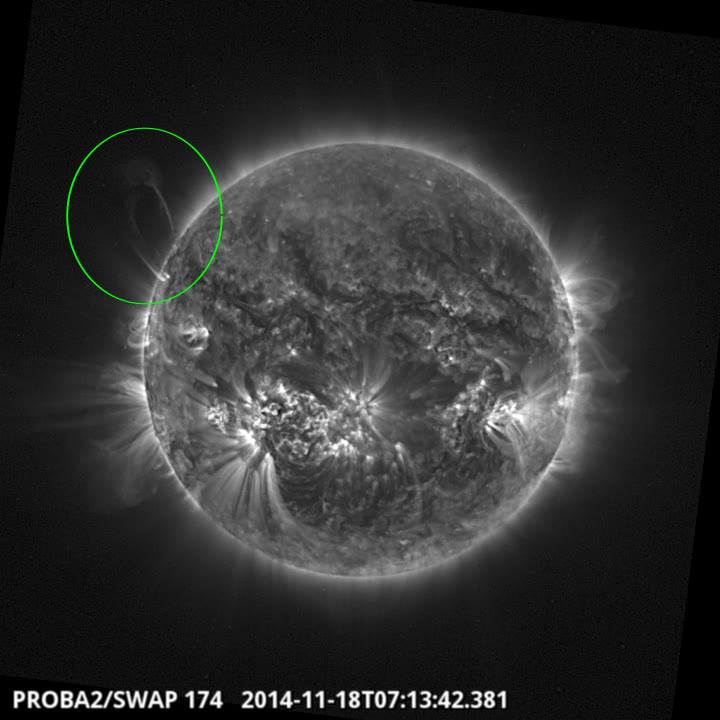
Eruption on north half @ 11:48 SWAP image
Find a movie of the event here (SWAP movie)
http://proba2.oma.be/swap/data/mpg/movies/20141111_swap_movie.mp4
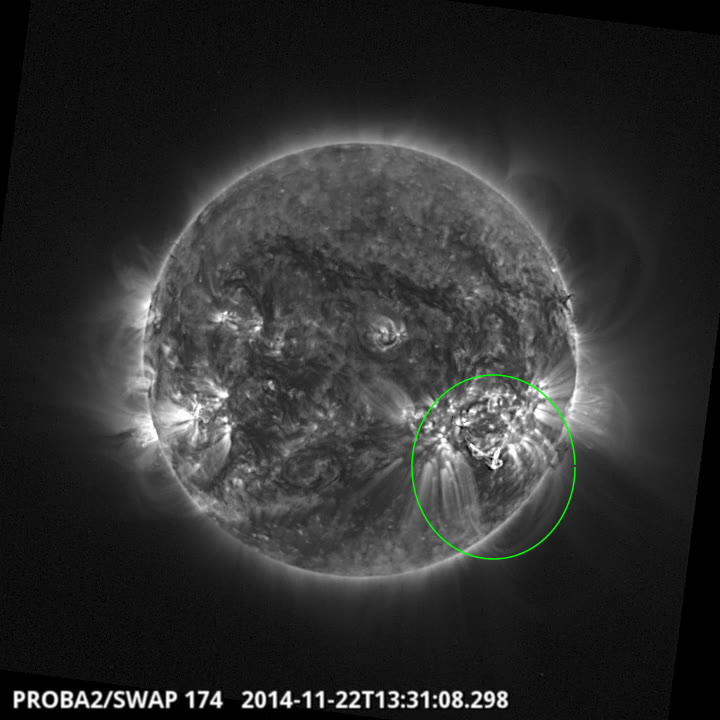
Flare on the south west quad @ 13:31 SWAP image
Find a movie of the event here (SWAP movie)
http://proba2.oma.be/swap/data/mpg/movies/20141122_swap_movie.mp4
Solar flaring activity was on the C-level throughout the week, produced mostly by the NOAA ARs 2209, 2216, and 2217 (Catania numbers 09, 14, and 18, respectively). The strongest flare of the week was the C8.1 flare peaking at 01:01 UT on November 22 in the NOAA AR 2209 (Catania number 09). None of the flares was associated with an Earth-directed CME.
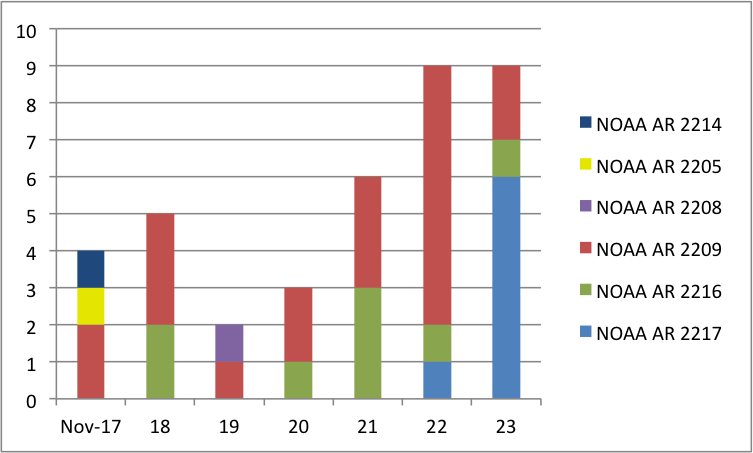
During the whole week the Earth was situated inside a slow solar wind flow. The interplanetary magnetic field magnitude was slightly increased (6-8 nT), so isolated intervals of active geomagnetic conditions (K = 4) were reported by Dourbes, IZMIRAN and NOAA among predominantly quiet to unsettled (K smaller than 4) geomagnetic conditions.
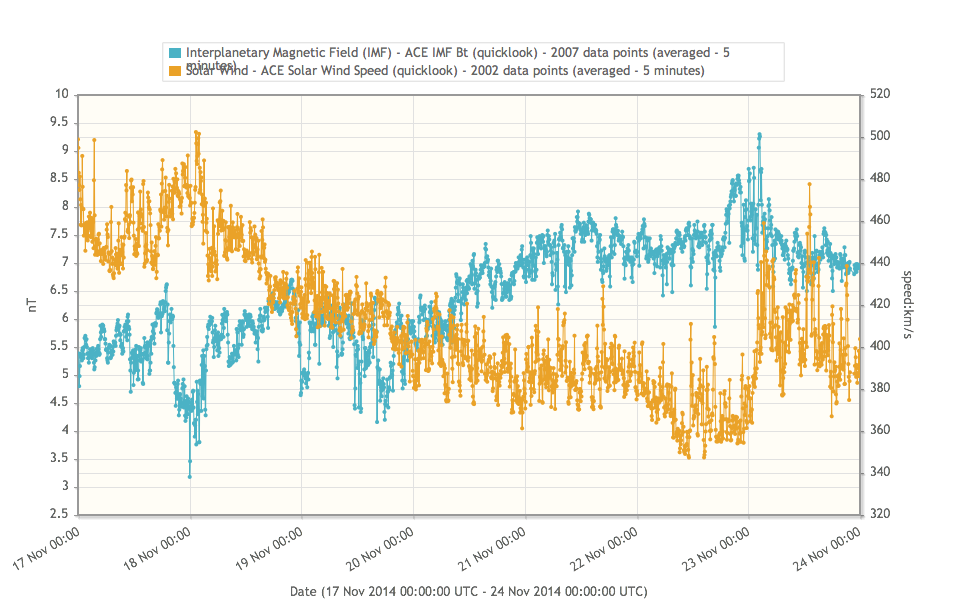
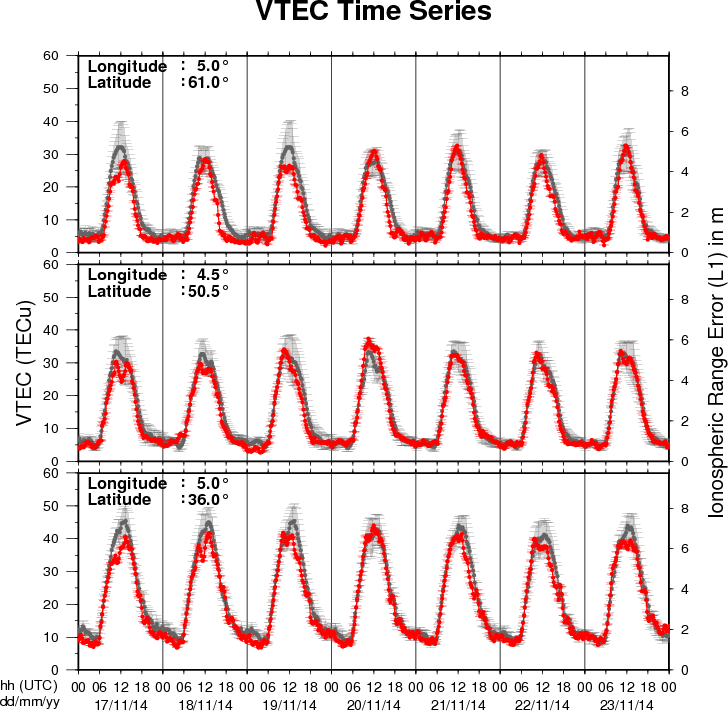
The figure shows the time evolution of the Vertical Total Electron Content (VTEC) (in red) during the last week at three locations:
a) in the northern part of Europe(N61°, 5°E)
b) above Brussels(N50.5°, 4.5°E)
c) in the southern part of Europe(N36°, 5°E)
This figure also shows (in grey) the normal ionospheric behaviour expected based on the median VTEC from the 15 previous days.
The VTEC is expressed in TECu (with TECu=10^16 electrons per square meter) and is directly related to the signal propagation delay due to the ionosphere (in figure: delay on GPS L1 frequency).
The Sun's radiation ionizes the Earth's upper atmosphere, the ionosphere, located from about 60km to 1000km above the Earth's surface.The ionization process in the ionosphere produces ions and free electrons. These electrons perturb the propagation of the GNSS (Global Navigation Satellite System) signals by inducing a so-called ionospheric delay.
See http://stce.be/newsletter/GNSS_final.pdf for some more explanations ; for detailed information, see http://gnss.be/ionosphere_tutorial.php
Start : 2015-10-05 - End : 2015-10-09
This CSPM-2015 scientific meeting will cover various aspects of
solar dynamic and magnetic phenomena which are observed over the
entire electromagnetic spectrum: white-light, Hα, Ca II,
and radio from ground and in a variety of other wavelengths (white
light, UV and EUV, and X-rays) from space. Emphasis will also be
placed on instrumentation, observing techniques, and solar image
processing techniques, as well as theory and modelling through
detailed radiative transfer in increasingly realistic MHD models.
The long-term (cyclic) evolution of solar magnetism and its
consequence for the solar atmosphere, eruptive phenomena, solar
irradiation variations, and space weather, will be in focus. Here,
special attention will be devoted to the long-term observations
made in Coimbra and also to the results of the SPRING / SOLARNET
and SCOSTEP VarSITI studies. In particular, the weak solar activity
during the current solar maximum will be discussed. Finally, since
this meeting is organised around the 90th anniversary of performing
the first spectroheliographic observations in Coimbra, a session
will be specially dedicated to new solar instruments (both
ground-based and space-borne) that will give access to unexplored
solar atmospheric features and dynamic phenomena over the coming
years.
Website:
http://www.mat.uc.pt/~cspm2015/
Start : 2016-07-30 - End : 2016-08-07
The 41st COSPAR Scientific Assembly will be held in Istanbul,
Turkey from 30 July - 7 August 2016. This Assembly is open to all
bona fide scientists.
Website:
https://www.cospar-assembly.org/
http://www.spaceweather.eu/en/repository/show?id=553
Presentation, in French, given at the open doors of the Space Pole, Belgium, 2014
http://www.spaceweather.eu/en/repository/show?id=552